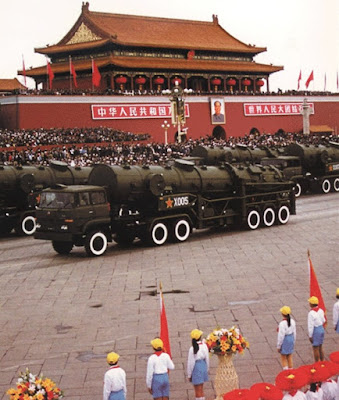 | Portrait of Chairman Mao Zedong at the Tiananmen Gate (Tiananmen literally, Gate of Heavenly Peace), Forbidden City, Beijing, China. DF-21 IRBM TEL's at National Day Parade in Beijing. 1 October 1999. Image Credit: The Office of the Director of National Intelligence |
Note: This only applies to works of the Federal Government and not to the work of any individual U.S. state, territory, commonwealth, county, municipality, or any other subdivision.
Generally speaking, works created by U.S. Government employees are not eligible for copyright protection in the United States. See Circular 1 "COPYRIGHT BASICS" from the U.S. Copyright Office.
The Tiananmen Gate was first built in the 1420s in the Ming Dynasty. During the demise of the Ming Dynasty, heavy fighting between Li Zicheng and the early Qing emperors damaged (or perhaps destroyed) the gate. The Tiananmen square was originally designed and built in Beijing in 1651. It was enlarged to its present size (four times its original size) and cemented over in 1958.
British and French troops who invaded Beijing in 1860 pitched camp near the gate and briefly considered burning the gate and the entire Forbidden City down. They decided ultimately to preserve the palace and to burn instead the emperor's Summer Palace. The Qing emperor eventually agreed to let the foreign powers establish headquarters in the area. During the Boxer Rebellion of 1900 the siege badly damaged the office complexes and several ministries were burnt down. In the conflict's denouement, the area became a space for foreign troops to assemble their armies and horses. It was cleared in due course to produce the beginning of what is now known as the Tiananmen Square. The Square, however, was not officially made until the PRC took power in 1949.
Near the centre of today's square, close to the site of the Mao Zedong Mausoleum, once stood one of the most important gates of Beijing. This gate was known as the "Great Ming Gate" during the Ming Dynasty, "Great Qing Gate" during the Qing Dynasty, and "Gate of China" during the Republic of China era. Unlike the other gates in Beijing, such as the Tiananmen and the Qianmen, this was a purely ceremonial gateway, with three arches but no ramparts, similar in style to the ceremonial gateways found in the Ming Dynasty Tombs.
This gate had a special status as the "Gate of the Nation", as can be seen from its successive names. It normally remained closed, except when the Emperor passed through. Commoner traffic was diverted to two side gates at the northern and eastern ends of today's square, respectively. Because of this diversion in traffic, a busy marketplace, called Chessgrid Streets developed in the big, fenced square to the south of this gate. In the early 1950s, the Gate of China (as it was then known) was demolished along with the Chessgrid Streets to the south, completing the expansion of Tiananmen Square to (approximately) its current size.
This article is licensed under the GNU Free Documentation License. It uses material from the Wikipedia article, Tiananmen Square SEE FULL License, Credit and Disclaimer
Tags: Public Domain Clip Art and clip art or public domain and Tiananmen Square Beijing, China












1 comment:
no mention of the massacre in Tienanmen Square?
Post a Comment